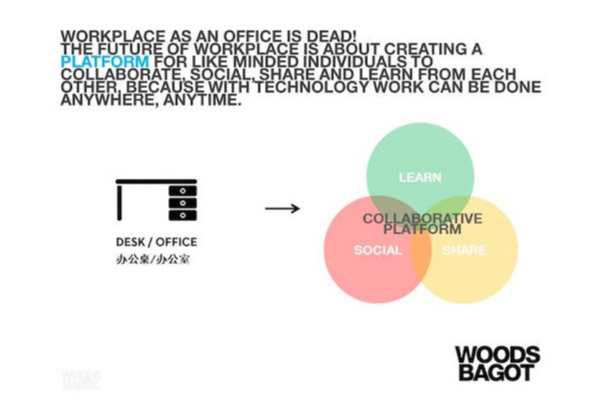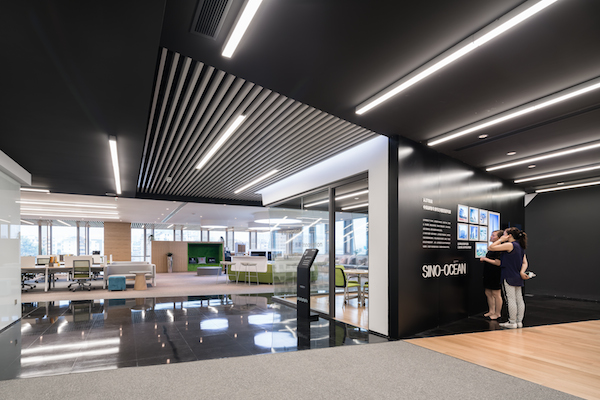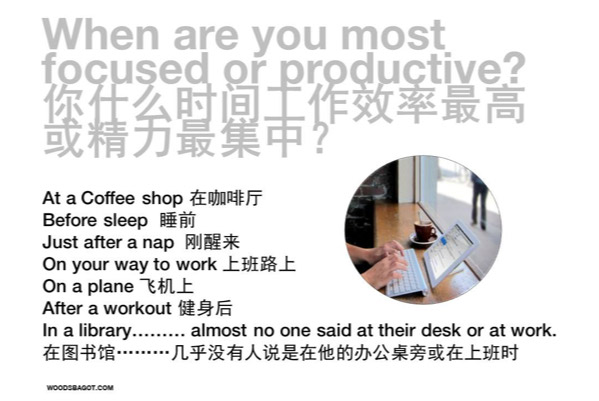It’s not just office design that is changing – it’s also how we work, and how we view work, that is transforming, and rapidly. Ray Yuen of Woods Bagot shares his vision of where work is going, and how workplace design can adapt to help it get there.

August 10th, 2016
Pictured above is one of Sino-Ocean Group’s offices, designed by Woods Bagot
“Work is what we do; it’s not where we go.” These words graced a slide that formed part of Ray Yuen’s talk at REACH Tokyo on 4 August 2016. Yuen, a Principal at the Beijing offices of international architectural design studio Woods Bagot, spoke about The Decentralised Office, giving the crowd his insights into how the concept of work is changing, explaining that, these days, it’s about much more than just desks and meeting rooms.
“Mobile technology has allowed us to work anywhere and anytime, which has decreased the need to work in traditional office environments,” said Yuen, speaking after his talks at REACH. “We need to stop thinking about workplace design in the context of simply installing a few desks and meeting rooms. Naturally, most of us now spend at least half of our workday away from our individual desk because we are mostly communicating and collaborating with others. Today’s workplace therefore needs to evolve into a collaborative platform for socialising, knowledge sharing and learning.”

The workplace will become a place to collaborate, said Yuen at REACH Tokyo and Beijing
REACH is a Herman Miller event; it’s a design festival that aims to connect the design industry in each of the cities it visits through open discussion, knowledge sharing, speaker events and playful interaction between people and products. REACH has already visited Beijing, Bangalore, Manila and Tokyo. The next stop for REACH? Melbourne on 15 September 2016.
Yuen spoke at REACH Beijing on 24 June 2016, followed by REACH Tokyo. His experience means he’s perfectly placed to see how approaches to work are changing, and how design can adapt to support this. He has spent over 15 years designing retail, hospitality and workplace interiors. Yuen and his team’s design methodology is about creating unique spatial experiences that are highly functional and that integrate with their client’s cultural values. He is currently working on Tencent Beijing’s headquarters and CCTV’s headquarters in China’s capital, alongside HP Inc.’s new flexible workspace in Beijing.

Different workspaces at Sino-Ocean’s offices by Woods Bagot
“Tencent is creating and developing Smart Cities, with everything controlled and tracked from an app on your mobile – this will change the way their workplaces function,” said Yuen. This is one way a company is dealing with what Yuen sees as a growing need to have a lifestyle offering within corporate offices. “It’s increasingly important to have F&B and wellness spaces within an office design; mainly to attract talent, especially for the IT giants, where talent is in short supply. It is common for clients to request that we create workplace environments that have a focus on hospitality,” he said.
According to Yuen, these spaces have a bigger purpose: “Whether they’re creating F&B spaces, a gym, games room or flexible, multifunctional spaces, workplace designers are actually designing a wide variety of spaces in order to retain workers within a workplace environment, and to fulfill the organisational need for interaction and collaboration that will in turn lead to innovation.”
Indeed, “innovation is now the key to success in most organisations,” said Yuen. “Innovation requires communication and collaboration between the brightest minds. And they need a workplace environment that enables that or they will need to go elsewhere outside the office. Not that there is anything wrong with getting out of the office, but what the company will lose is that opportunity for spontaneous knowledge sharing between team members.”

In his presentation, Yuen looked at where we are most productive, and it’s not at our desks
Also important for organisations is building a sense of community, said Yuen. “This attracts staff and encourages them to stay with a company.”
What are Yuen’s predictions for the workplace of the future? “I think this idea of workplace being a place in which to produce work will disappear,” he said. “Technology will continue to advance rapidly, eventually deleting the need to physically go to an office to work. The concept of the workplace will then change to a place to share, learn and also to represent an individual’s beliefs or values.”
Herman Miller
hermanmiller.com
Herman Miller REACH
hermanmillerreach.com
Woods Bagot
woodsbagot.com
A searchable and comprehensive guide for specifying leading products and their suppliers
Keep up to date with the latest and greatest from our industry BFF's!

Channelling the enchanting ambience of the Caffè Greco in Rome, Budapest’s historic Gerbeaud, and Grossi Florentino in Melbourne, Ross Didier’s new collection evokes the designer’s affinity for café experience, while delivering refined seating for contemporary hospitality interiors.

Suitable for applications ranging from schools and retail outlets to computer rooms and X-ray suites, Palettone comes in two varieties and a choice of more than fifty colours.

Create a configuration to suit your needs with this curved collection.

In the pursuit of an uplifting synergy between the inner world and the surrounding environment, internationally acclaimed Interior Architect and Designer Lorena Gaxiola transform the vibration of the auspicious number ‘8’ into mesmerising artistry alongside the Feltex design team, brought to you by GH Commercial.

Explore the future of cancer treatment at the Australian Bragg Centre, where a revolutionary design by Woods Bagot integrates cutting-edge proton therapy with patient-centric features, including natural light and adaptive Verosol blinds, creating a space that merges innovation and empathy for a holistic healing journey.

In this comment piece republished from INDESIGN #90, Woods Bagot’s Global Sustainability Leader in Los Angeles brings questions of equality to design in the climate crisis.
The internet never sleeps! Here's the stuff you might have missed

Set to undergo a $60-million revitalisation, the National Gallery of Australia has announced the launch of a landscape design competition for its Sculpture Garden.

Drawing on the concept of a watering hole as a gathering place in nature, GroupGSA has rejuvenated Sydney Water’s headquarters located in Parramatta.

Swiss home appliance designer and manufacturer V-ZUG’s first Sydney studio is a unified expression of the brand’s boutique, sustainable and design-led identity.

Savage Design’s approach to understanding the relationship between design concepts and user experience, particularly with metalwork, transcends traditional boundaries, blending timeless craftsmanship with digital innovation to create enduring elegance in objects, furnishings, and door furniture.